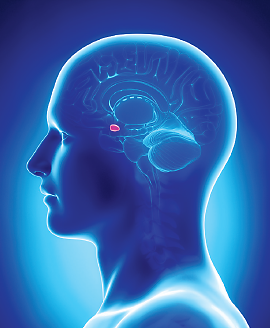Amygdala Size May Give Clue to Violence Risk
Abstract
Could it be that the size of the amygdala plays a role in influencing an individual's actions?

The amygdala is highlighted in this illustration. Researchers found that lower amygdala volume is a significant risk factor for future violent behavior.
The amygdala—that almond-shaped structure that sits in front of the hippocampus—is considered the brain’s fear center. But when it is unduly small, it may contribute not to fear, but to aggressive, even violent, behaviors, a new prospective study suggests.
The findings were published May 6 in Biological Psychiatry. The lead researcher was Dustin Pardini, Ph.D., an assistant professor of psychiatry and psychology at the University of Pittsburgh. The senior researcher was Adrian Raine, Ph.D., a professor of criminology, psychiatry, and psychology at the University of Pennsylvania. Raine has been exploring the brains of antisocial individuals for several years (Psychiatric News, October 16, 2009).
In 1987, two University of Pittsburgh researchers—Rolf Loeber, Ph.D., and Magda Stouthamer-Loeber, Ph.D.—launched the Pittsburgh Youth Study, a longitudinal study of some 500 inner-city boys. Its goal was to document the development of antisocial and delinquent behavior from childhood to early adulthood. Pardini joined the research team nine years ago and is now codirector of the study with Loeber.
Pardini, Raine, Loeber, and Kirk Erickson, Ph.D., decided to use the Pittsburgh Youth Study for a new investigation. They recruited 56 men who had participated in the Pittsburgh Youth Study up to age 26 and whose levels of aggression and psychopathic features during childhood, adolescence, and early adulthood had been measured. According to self-assessment and criminal records, 20 had a history of chronic serious violence, 16 had a history of transient serious violence, and 20 had a history of no serious violence.
The researchers used structural MRI imaging to measure the amygdalae of the 56 subjects. They then assessed whether there was any correlation between amygdala size and levels of aggression and psychopathic features subjects had shown in childhood and adolescence, taking potential confounds such as race, age, handedness, IQ, concussion, and childhood maltreatment into consideration.
They found that subjects with smaller amygdalae exhibited significantly more aggression and psychopathic features in childhood and adolescence than did subjects with larger amygdalae.
Pardini, Raine, and their team then followed the subjects for three more years and during this time evaluated them for aggression, violence, and psychopathic traits. The researchers then evaluated whether there was an association between the size of the subjects’ amygdalae three years earlier and their subsequent aggression, violence, and psychopathic traits, even after controlling for earlier levels of these features and other potential confounds.
Those with smaller amygdalae were three times more likely than those with larger amygdalae to exhibit aggression, violence, and psychopathic features three years later, they found.
“This is the first study to demonstrate that lower amygdalae volume is associated with features of aggression and psychopathy spanning from childhood to young adulthood,” the researchers concluded. “It is also the first investigation to demonstrate that lower amygdala volume is a significant risk factor for future violent behavior.”
Pardini told Psychiatric News that he and his colleagues do not think there are immediate clinical implications for their findings. “Research examining the neurobiological factors that may influence the development and persistence of violence and psychopathic features is still in its infancy….This study suffered from several limitations such as the use of a relatively small sample….Replication of the findings by other investigators using different samples is necessary….And we also need to better understand how structural differences in the amygdala impact not only violent behavior, but other of the amygdala’s functions such as fear conditioning and moral decision making.”
The study was funded by the National Institute on Drug Abuse, National Institute of Mental Health, Pew Charitable Trusts, and the Office of Juvenile Justice and Delinquency Prevention. ■
An abstract of “Lower Amygdala Volume in Men Is Associated With Childhood Aggression, Early Psychopathic Traits, and Future Violence” is posted at http://www.biologicalpsychiatryjournal.com/article/S0006-3223(13)00312-0/abstract.



